Titian art & life
Tiziano Vecellio, or Vecelli the greatest Italian Renaissance painter of the Venetian school. He was recognized early in his own lifetime as a supremely great painter, and his reputation has in the intervening centuries never suffered adecline. In 1590 the art theorist Giovanni Lomazzo declared him "the sun amidst small stars not only among the Italians but all the painters of the world."
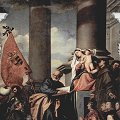 The
universality of Titian's genius is not questioned today, for he was
surpassingly great in all aspects of the painter's art. In his
portraits he searched and penetrated human character and recorded it
in canvases of pictorial brilliance. His religious compositions cover
the full range of emotion from the charm of his youthful Madonnas to
the tragic depths of the late "Crucifixion" and the "Entombment." In
his mythological pictures he captured the gaiety and abandon of the
pagan world of antiquity, and in his paintings of the nude Venus
("Venus and Adonis") and the Danae ("Danae with Nursemaid") he set a
standard for physical beauty and often sumptuous eroticism that has
never been surpassed. Other great masters - Rubens and Nicolas Poussin, for example - paid him the
compliment of imitation.
The
universality of Titian's genius is not questioned today, for he was
surpassingly great in all aspects of the painter's art. In his
portraits he searched and penetrated human character and recorded it
in canvases of pictorial brilliance. His religious compositions cover
the full range of emotion from the charm of his youthful Madonnas to
the tragic depths of the late "Crucifixion" and the "Entombment." In
his mythological pictures he captured the gaiety and abandon of the
pagan world of antiquity, and in his paintings of the nude Venus
("Venus and Adonis") and the Danae ("Danae with Nursemaid") he set a
standard for physical beauty and often sumptuous eroticism that has
never been surpassed. Other great masters - Rubens and Nicolas Poussin, for example - paid him the
compliment of imitation.
Early life and works
The traditional date of Titian's birth was long given as 1477,but today most critics favour the later date of 1488/90. Titian was the son of a modest official, Gregorio di Conte dei Vecelli, and his wife, Lucia. He was born in the small village of Pieve di Cadore, located high amid mountain peaks of the Alps, straight north of Venice and not far from the Austrian Tyrol. At the age of nine he set out for Venice with his brother, Francesco, to live there with an uncle and to become an apprentice to Sebastiano Zuccato, a master of mosaics. The boy soon passed to the workshop of the Bellini, where his true teacher became Giovanni Bellini, the greatest Venetian painter of the day.
Titian's early works are richly evident of his schooling and also of his association as a young man with another follower of the elderly Giovanni Bellini, namely, Giorgione of Castelfranco (1477-1510). Their collaboration in 1508 on the frescoes of the Fondaco dei Tedeschi (the German Exchange) is the point of departure for Titian's career, and it explains why it is difficult to distinguish between the two artists in the early years of the 16th century. Only ruined outlines of the frescoes survive, the "Allegory of Justice" being the chief scene assigned to Titian. The etchings (1760) of the frescoes by Antonio Maria Zanetti, already in a much faded condition, give a better notion of the idealism and the sense of physical beauty that characterize both artists' work. The problem of distinguishing between the paintings of Giorgione and the young Titian is virtually insuperable, for there is little solid evidence and even less agreement among critics about the attribution of several works. The present tendency among Italian writers is to assign far too much to Titian in his youth.
It is certain that Titian's first independent commission was for the frescoes of three miracles of St. Anthony of Padua. The finest in composition is the "Miracle of the Speaking Infant"; another, the "Miracle of the Irascible Son", has a very beautiful landscape background that demonstrates how similar in topography and mood were Titian's and Giorgione's works at this time. In fact, after Giorgione's deathin 1510, Titian assumed the task of adding the landscape background to Giorgione's unfinished "Sleeping Venus" (Gemaldegalerie, Dresden), a fact recorded by a contemporary writer, Marcantonio Michiel. Still Giorgionesque is the somewhat more lush setting of Titian's "Baptism of Christ" (c. 1515, Capitoline Museum, Rome), in which the donor, Giovanni Ram, appears at the lower right.
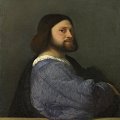 The authorship of individual
portraits is the most difficult of all to establish, but the
"Gentleman in Blue" (so-called "Ariosto") is certainly Titian's
because it is signed with the initials T.V. (Tiziano Vecellio). The
volume and the interest in texture in the quilted sleeve seem to
identify Titian's own style. On the other hand, "The Concert" has been
one of the most debated portraits, because since the 17th century it
was thought to be most typical of Giorgione. The
pronouncedpsychological content as well as the notable clarity of
modelling in the central figure has led 20th-century critics to favour
Titian. Technique and the clear intelligence of the young Venetian
aristocrat in the "Young Man with Cap and Gloves" has led modern
critics to attribute this and similar portraits to Titian.
The authorship of individual
portraits is the most difficult of all to establish, but the
"Gentleman in Blue" (so-called "Ariosto") is certainly Titian's
because it is signed with the initials T.V. (Tiziano Vecellio). The
volume and the interest in texture in the quilted sleeve seem to
identify Titian's own style. On the other hand, "The Concert" has been
one of the most debated portraits, because since the 17th century it
was thought to be most typical of Giorgione. The
pronouncedpsychological content as well as the notable clarity of
modelling in the central figure has led 20th-century critics to favour
Titian. Technique and the clear intelligence of the young Venetian
aristocrat in the "Young Man with Cap and Gloves" has led modern
critics to attribute this and similar portraits to Titian.
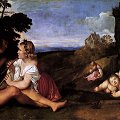 The earliest compositions
on mythological or allegorical themes show the young artist still
under the spell of Giorgione in his creation of a poetic Arcadian
world where nothing commonplace or sordid exists. The inspiration lies
in the idyllic world of the love lyrics of the 16th-century Italian
poets Jacopo Sannazzaro and Pietro Bembo. "The Three Ages of Man",
where the erotic relationship of the young couple is discreetly muted
and a mood of tenderness and sadness prevails, is one of the most
exquisite of these. The contemporary "Sacred and Profane Love" is
likewise set in a landscape of extraordinary beauty, but here the
allegory is less easily understood. The most generally accepted
interpretation holds that the two women are the twin Venuses,
according to Neoplatonic theory and symbolism. The terrestrial Venus,
on the left, stands for the generative forces of nature, both physical
and intellectual, while the nude Venus, on the right, represents
eternal and divine love. Essentially an ideally beautiful young woman
rather than a cruel biblical antiheroine is the lovely "Salome."
The earliest compositions
on mythological or allegorical themes show the young artist still
under the spell of Giorgione in his creation of a poetic Arcadian
world where nothing commonplace or sordid exists. The inspiration lies
in the idyllic world of the love lyrics of the 16th-century Italian
poets Jacopo Sannazzaro and Pietro Bembo. "The Three Ages of Man",
where the erotic relationship of the young couple is discreetly muted
and a mood of tenderness and sadness prevails, is one of the most
exquisite of these. The contemporary "Sacred and Profane Love" is
likewise set in a landscape of extraordinary beauty, but here the
allegory is less easily understood. The most generally accepted
interpretation holds that the two women are the twin Venuses,
according to Neoplatonic theory and symbolism. The terrestrial Venus,
on the left, stands for the generative forces of nature, both physical
and intellectual, while the nude Venus, on the right, represents
eternal and divine love. Essentially an ideally beautiful young woman
rather than a cruel biblical antiheroine is the lovely "Salome."
Mature life and works
Sometime in the early 1520s Titian brought to his house in Venice a young woman from Cadore whose name was Cecilia. Two sons were born in 1524 and 1525, first Pomponio, who became a priest, and second Orazio, later a painter and Titian's chief assistant. During Cecilia's grave illness in 1525, Titian married her. She recovered and later gave birth to two daughters, Lavinia (born 1529/30) and another who died in infancy. On Cecilia's death in 1530, the artist was disconsolate and he never remarried.
Mythological paintings
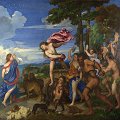 Titian's fame had spread
abroad, and Alfonso I d'Este sough thim as one of the chief masters in
a cycle of mythological compositions for his newly rebuilt rooms
called the Alabaster Chambers in the castle at Ferrara. Two of the
canvases are "Worship of Venus" and "The Andrians"; one
of the most spectacular, the "Bacchus and Ariadne". The gaiety
of mood, the spirit of pagan abandon, and the exquisite sense of
humour in this interpretation of an idyllic world of antiquity make it
one of the miracles of Renaissance art. Warmth and richness of colour
help to balance the intentionally asymmetrical grouping of the
figures, placed in richly verdant landscape that is also an integral
part of the design. At this time Titian partially repainted the
background of Giovanni Bellini's "Feast of the Gods", so that the
picture would better fit the series in the same room at Ferrara.
Titian's fame had spread
abroad, and Alfonso I d'Este sough thim as one of the chief masters in
a cycle of mythological compositions for his newly rebuilt rooms
called the Alabaster Chambers in the castle at Ferrara. Two of the
canvases are "Worship of Venus" and "The Andrians"; one
of the most spectacular, the "Bacchus and Ariadne". The gaiety
of mood, the spirit of pagan abandon, and the exquisite sense of
humour in this interpretation of an idyllic world of antiquity make it
one of the miracles of Renaissance art. Warmth and richness of colour
help to balance the intentionally asymmetrical grouping of the
figures, placed in richly verdant landscape that is also an integral
part of the design. At this time Titian partially repainted the
background of Giovanni Bellini's "Feast of the Gods", so that the
picture would better fit the series in the same room at Ferrara.
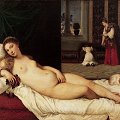 The standard for the reclining nude female obliquely
placed in the picture space was established by Giorgione in the
"Sleeping Venus." In Titian's "Venus of Urbino" the ideal
rendering of the body and the position remain virtually unchanged,
except that the goddess is awake and reclines upon a couch within the
spacious room of a palace. For sheer beauty of form these two works
were never surpassed. Despite the inherent eroticism of the subject,
Titian managed it with restraint and good taste. Variations on the
theme recur throughout his career.
The standard for the reclining nude female obliquely
placed in the picture space was established by Giorgione in the
"Sleeping Venus." In Titian's "Venus of Urbino" the ideal
rendering of the body and the position remain virtually unchanged,
except that the goddess is awake and reclines upon a couch within the
spacious room of a palace. For sheer beauty of form these two works
were never surpassed. Despite the inherent eroticism of the subject,
Titian managed it with restraint and good taste. Variations on the
theme recur throughout his career.
Religious paintings
Among the religious paintings Titian produced between 1516 and 1538 is one of his most revolutionary masterpieces, the "Assumption" (1516-18). This large and at the same time monumental composition occupies the high altar of Sta. Maria dei Frari in Venice, a position that fully justifies the spectacular nature of the Virgin's triumph as she ascends heavenward, accompaniedby a large semicircular array of angels, while the startled Apostles gesticulate in astonishment at the miracle. When the painting was unveiled it was quickly recognized as the work of a very great genius.
The posture of the Madonna in the "Assumption" and the composition of Titian's "Madonna and Child with SS. Francis and Alvise and Alvise Gozzi as Donor" reveal the influence of Titian's contemporary Raphael; and the pose of St. Sebastian in the "Resurrection Altarpiece", the influence of Michelangelo. These influences, however, are of secondary importance since the landscapes, the physical types, and the colour are totally Titian's own.
In the "Pesaro Madonna" (1519-26) Titian created a new type of composition, in which the Madonna and Saints with the male members of the Pesaro family are placed within a monumental columnar portico of a church. The picture is flooded with sunlight and shadows. This work established a formula that was widely followed by later Venetian Renaissance painters and served as an inspiration for some Baroque masters, including Rubens and Van Dyck.
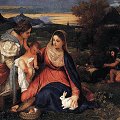 Such a
quantity of masterpieces by Titian followed that only a few can be
mentioned. The poetic charm of the artist's pictures with landscape
continues in the "Madonna and Child with St. Catherine and a Rabbit"
and the "Madonna and Child with SS. John the Baptist and Catherine of
Alexandria" (c. 1530). The "Entombment" is his first tragic
masterpiece, where in a twilight setting the irrevocable finality of
death and the despair of Christ's followers are memorably evoked. The
stately "Presentation of the Virgin in the Temple", a very large
canvas, reflects the splendour of Venetian Renaissance society in the
great architectural setting, partlyin the latest style of the
contemporary architects Serlio and Jacopo Sansovino. The pageantry of
the scene also belongs to well-established tradition in Venetian art,
but the organization, with its emphasis on verticals and horizontals,
constitutes Titian's interpretation of the High Renaissance style.
Such a
quantity of masterpieces by Titian followed that only a few can be
mentioned. The poetic charm of the artist's pictures with landscape
continues in the "Madonna and Child with St. Catherine and a Rabbit"
and the "Madonna and Child with SS. John the Baptist and Catherine of
Alexandria" (c. 1530). The "Entombment" is his first tragic
masterpiece, where in a twilight setting the irrevocable finality of
death and the despair of Christ's followers are memorably evoked. The
stately "Presentation of the Virgin in the Temple", a very large
canvas, reflects the splendour of Venetian Renaissance society in the
great architectural setting, partlyin the latest style of the
contemporary architects Serlio and Jacopo Sansovino. The pageantry of
the scene also belongs to well-established tradition in Venetian art,
but the organization, with its emphasis on verticals and horizontals,
constitutes Titian's interpretation of the High Renaissance style.
Portraits
One of Titian's great triumphs came when he answered the call to Bologna in 1530 at the time of Charles V's coronation as Holy Roman emperor. In 1531, in keeping with his social state, he moved to a Venetian palace known as the Casa Grande, which survives as a 20th-century slum. Titian returned to Bologna to portray Charles V again on the occasion of the second meeting of Charles V and Pope Clement VII in the winter of 1532-33. The portrait of "Charles V in Armour" (1530) and another painted in January 1533 are lost, while only a less important work, "Charles V with Hound" (1532-33; Prado, Madrid), a copy of a portrait by Jakob Seisenegger, survives. Charles was so pleased with Titian's work that in May 1533 he bestowed upon the artist the most extraordinary honour of knighthood. Thereafter, the Austrian-Spanish Habsburgs remained Titian's most important patrons. Charles attempted to induce Titian to go to Spain in 1534 to prepare a portrait of the Empress, but the artist wisely refrained from undertaking the arduous journey.
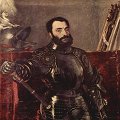 Titian's other portraits in the 1520s and 1530s provide a
gallery of the leading aristocrats of Italy. A splendid exampleis
"Alfonso d'Avalos, Marques del Vasto" (1533), brilliantly
rendered in gleaming armour ornamented with gold. He is accompanied by
a small page whose head reaches his waist. The introduction of a
secondary figure to give scale is a device frequently adopted by
Titian. Another refulgent portrait in armour, but without the
secondary figure, is that of "Francesco Maria della Rovere, Duke of
Urbino" (1536-38). Emphasis here is given to the Duke's military
career, not only by the armour but also by the baton in hand and the
three others in the background. These works are essentially idealized
state portraits, although the heads are very convincingly rendered.
"Doge Andrea Gritti" is to a greater extent a symbol of the
office-that is, that of ruler of Venice. The gigantic body in a canvas
of large size is sweeping in design and commanding in presence. In
later works, too, Titian very effectively managed the scaling of a
figure to appear massive by filling the space of the canvas-in his
portraits of Pietro Aretino, for example, where he gives his subject a
leonine bulkiness. Allowing more space around the figure in "The Young
Englishman", he projected a personality of cultivated elegance and
human warmth.
Titian's other portraits in the 1520s and 1530s provide a
gallery of the leading aristocrats of Italy. A splendid exampleis
"Alfonso d'Avalos, Marques del Vasto" (1533), brilliantly
rendered in gleaming armour ornamented with gold. He is accompanied by
a small page whose head reaches his waist. The introduction of a
secondary figure to give scale is a device frequently adopted by
Titian. Another refulgent portrait in armour, but without the
secondary figure, is that of "Francesco Maria della Rovere, Duke of
Urbino" (1536-38). Emphasis here is given to the Duke's military
career, not only by the armour but also by the baton in hand and the
three others in the background. These works are essentially idealized
state portraits, although the heads are very convincingly rendered.
"Doge Andrea Gritti" is to a greater extent a symbol of the
office-that is, that of ruler of Venice. The gigantic body in a canvas
of large size is sweeping in design and commanding in presence. In
later works, too, Titian very effectively managed the scaling of a
figure to appear massive by filling the space of the canvas-in his
portraits of Pietro Aretino, for example, where he gives his subject a
leonine bulkiness. Allowing more space around the figure in "The Young
Englishman", he projected a personality of cultivated elegance and
human warmth.
Travels and commissions
Portraits
 The large number of masterpieces in portraiture that
Titian continued to create throughout the rest of his life is
astounding. Pope Paul III and his grandson, Cardinal Alessandro
Farnese, began to compete with Emperor Charles V for Titian's
services. At the request of the Pope, the painter travelled to Bologna
in May 1543 and there prepared the celebrated official portrait of
"Pope Paul III Without Cap". Although a state symbol of the
Pontiff, the characterization of the crafty statesman, bent with age,
comes through.
The large number of masterpieces in portraiture that
Titian continued to create throughout the rest of his life is
astounding. Pope Paul III and his grandson, Cardinal Alessandro
Farnese, began to compete with Emperor Charles V for Titian's
services. At the request of the Pope, the painter travelled to Bologna
in May 1543 and there prepared the celebrated official portrait of
"Pope Paul III Without Cap". Although a state symbol of the
Pontiff, the characterization of the crafty statesman, bent with age,
comes through.
Titian's next major association with the Farnese came in 1545-46, when he made his only visit to Rome, lodged in the Belvedere Palace of the Vatican. For the first time Titian was able to see the archaeological remains of ancient Rome and also the Renaissance masterpieces of Michelangelo, Raphael, Sebastiano del Piombo, and others. The effect upon the master's own style was relatively slight, understandably enough, since he was already a mature and famous artist.
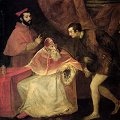 Of portraits of the
Farnese family carried out at this time, fewremain. The most
celebrated of all is "Paul III and His Grandsons Ottavio and
Cardinal Alessandro Farnese" (1546). A painting of a family group,
it is most searching in psychological revelation. The feeble Pope,
then aged 78, appears to turn suddenly in his chair toward Ottavio
Farnese, his 22-year-old grandson. Ottavio's overly obsequious bow and
his shrewd Machiavellian profile demonstrate Titian's sheer genius in
understanding and recording character. As a foil, the great churchman
Cardinal Alessandro Farnese stands quietly by. It is no wonder that
the portrait is not completely finished, for Paul III must have found
it too revealing of the feud within the Farnese family.
Of portraits of the
Farnese family carried out at this time, fewremain. The most
celebrated of all is "Paul III and His Grandsons Ottavio and
Cardinal Alessandro Farnese" (1546). A painting of a family group,
it is most searching in psychological revelation. The feeble Pope,
then aged 78, appears to turn suddenly in his chair toward Ottavio
Farnese, his 22-year-old grandson. Ottavio's overly obsequious bow and
his shrewd Machiavellian profile demonstrate Titian's sheer genius in
understanding and recording character. As a foil, the great churchman
Cardinal Alessandro Farnese stands quietly by. It is no wonder that
the portrait is not completely finished, for Paul III must have found
it too revealing of the feud within the Farnese family.
If one were forced to name Titian's two greatest portraits, the choice might fall upon the Farnese group and upon another, "The Vendramin Family". Here the situation is quite different, for the two heads of the clan kneel in adoration of are liquary of the Holy Cross, accompanied by seven sons ranging in age from about eight to 20. This portrait group is a tour de force in technical brilliance, richly beautiful in colour, running the emotional gamut from gravity to the innocence of childhood.
On his departure from Rome, in June 1546, Titian's association with the Farnese ended. He received no payment for his pictures, and his hopes for recompense in the form of a benefice for his son Pomponio were never realized. Titian decided to throw in his lot with the Habsburgs. Consenting to undertake the arduous journey to Augsburg, he set out in thedepths of winter in January 1548 to cross the Alps to reach the Emperor's court. There he carried out one of his most memorable works, the equestrian "Emperor Charles V at Muhlberg", designed to commemorate the Emperor's victory over the Protestants the year before. It is the great state portrait par excellence, intended to show the Emperor as a Christian knight, as he wished posterity to remember him. Titian minimized the disfiguring lantern jaw and gave great dignity of bearing to his subject. In sheer mastery of the painter's art, the picture is unsurpassed. The handsome armour, with its gleaming highlights and reflected colour, therose sash across the chest (a symbol of the Catholic party and the Holy Roman Empire), and the superb sunset landscape all contribute to make it one of the masterpieces of all time.
In December 1548 Charles instructed Titian to proceed to Milan to prepare likenesses of Prince Philip on his first trip outside of Spain. Once again, in the fall of 1550, Charles obliged Titian to travel to Augsburg to remain until May 1551, when he executed one of his greatest state portraits, the "Philip II" in full length. In this portrait of Philip, when stilla prince aged 23, Titian achieved another tour de force in sheer beauty of painting, and he treated gently the surly face of the arrogant young man.
Religious paintings
Like some of Titian's earlier religious paintings, "Christ Before Pilate" is a work in which Titian managed a large crowd in a processional manner leading to the focal point, the figure of Christ at the left. Here the people are in a state of turmoil as they demand Christ's crucifixion. The composition, however, marks a new phase in Titian's development, far removed from the Renaissance serenity of the "Presentation", which is not explainable by the subject alone. The compact massing of figures, the oblique position of the steps and the wall at the left, and the general effect of excitement are indicative of the mid-16th-century style known as Mannerism. Titian assimilated and recreated, however, to produce a masterpiece far surpassing anything of which the Mannerist artists were capable.
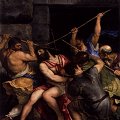 Titian's religious
compositions after his visit to Rome in 1545-46 reveal to some degree
his contact with ancient art and the works of Michelangelo. In
"Christ Crowned with Thorns" the burly muscular figures are
thus explained, as perhaps is the violence of the whole
interpretation.
Titian's religious
compositions after his visit to Rome in 1545-46 reveal to some degree
his contact with ancient art and the works of Michelangelo. In
"Christ Crowned with Thorns" the burly muscular figures are
thus explained, as perhaps is the violence of the whole
interpretation.
Last years in Venice
On his return to Venice in 1551, Titian remained there for the rest of his life except for summer visits to his native city of Pieve di Cadore. In his last 25 years his productivity was undiminished in quantity and in creative ideas.
Portraits
 Among his portraits is
the full-length, dashingly rendered figure of the Duke of Atri, who is
dressed in red velvet. One ofthe latest and most dramatic was
"Jacopo Strada", in which this brilliant antiquarian, writer,
and art collector is shown presenting to the spectator a small statue,
a Roman copy of an Aphrodite of Praxiteles. Here again, the scope and
varietyof Titian's invention is astonishing in this new composition,
so notable for lively action, psychological perception, and pictorial
beauty. One must not forget Titian's "Self Portrait", in which
he presents himself with great dignity, wearing the golden chain of
knighthood. The intelligent, tired face is fully rendered, while the
costume is sketched in lightly with a free brush. One of the most
remarkable late works is the "Triple Portrait Mask" or
"Allegory of Prudence", in which Titian, gray-bearded and
wearing a rose-coloured cap, represents old age, his son Orazio,
maturity, and presumably Marco Vecellio stands for youth.
Among his portraits is
the full-length, dashingly rendered figure of the Duke of Atri, who is
dressed in red velvet. One ofthe latest and most dramatic was
"Jacopo Strada", in which this brilliant antiquarian, writer,
and art collector is shown presenting to the spectator a small statue,
a Roman copy of an Aphrodite of Praxiteles. Here again, the scope and
varietyof Titian's invention is astonishing in this new composition,
so notable for lively action, psychological perception, and pictorial
beauty. One must not forget Titian's "Self Portrait", in which
he presents himself with great dignity, wearing the golden chain of
knighthood. The intelligent, tired face is fully rendered, while the
costume is sketched in lightly with a free brush. One of the most
remarkable late works is the "Triple Portrait Mask" or
"Allegory of Prudence", in which Titian, gray-bearded and
wearing a rose-coloured cap, represents old age, his son Orazio,
maturity, and presumably Marco Vecellio stands for youth.
Religious paintings
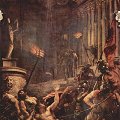 The "Trinity"
(or "La Gloria"), painted for Charles V's personal devotion,
reflects central Italian art to a lesser degree than the earlier
"Christ Crowned with Thorns." The glowing richness of colour
predominates in this adoration of the Trinity in which Charles V and
his family appear among the elect. The "Martyrdom of St.
Lawrence" marks a further step in new compositional directions
that culminate in Baroque form in the following century. St. Lawrence
upon his gridiron is placed obliquely in space, and the steps reverse
the direction to the right. Although dramatic power invests the main
action in the foreground, the night scene with the tall flares and
mysterious light suggests the supernatural.
The "Trinity"
(or "La Gloria"), painted for Charles V's personal devotion,
reflects central Italian art to a lesser degree than the earlier
"Christ Crowned with Thorns." The glowing richness of colour
predominates in this adoration of the Trinity in which Charles V and
his family appear among the elect. The "Martyrdom of St.
Lawrence" marks a further step in new compositional directions
that culminate in Baroque form in the following century. St. Lawrence
upon his gridiron is placed obliquely in space, and the steps reverse
the direction to the right. Although dramatic power invests the main
action in the foreground, the night scene with the tall flares and
mysterious light suggests the supernatural.
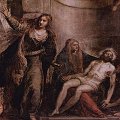 In his late religious pictures Titian veils the human forms
in shadowy light and so increases the dominant mood of spirituality.
One sees this effect in the late "Entombment", in which muted
colour prevails, and in the awesome tragedy of the
"Crucifixion". The "Christ Crowned with Thorns", employing
essentially the same composition as in the earlier version, is now
seen through a veil of darkness, and the colour is broken into tiny
spots and areas. All is miraculous in the "Annunciation", in which
Gabriel rushes in and an assembly of angels in glory hovers about the
Virgin. Titian's final word and last testament is the "Pieta",
intended for his own burial chapel but left unfinished and completed
by Palma il Giovane. The master and his son, Orazio, appear as tiny
donors on the small plaque to the right. The monumentality of the
composition is established by the great architectural niche flanked by
Moses and the Hellespontic sibyl, while the figures are grouped in a
long diagonal. The subdued colour befits the all-prevailing sorro wand
the immutability of death in this, one of the artist's most profound
achievements.
In his late religious pictures Titian veils the human forms
in shadowy light and so increases the dominant mood of spirituality.
One sees this effect in the late "Entombment", in which muted
colour prevails, and in the awesome tragedy of the
"Crucifixion". The "Christ Crowned with Thorns", employing
essentially the same composition as in the earlier version, is now
seen through a veil of darkness, and the colour is broken into tiny
spots and areas. All is miraculous in the "Annunciation", in which
Gabriel rushes in and an assembly of angels in glory hovers about the
Virgin. Titian's final word and last testament is the "Pieta",
intended for his own burial chapel but left unfinished and completed
by Palma il Giovane. The master and his son, Orazio, appear as tiny
donors on the small plaque to the right. The monumentality of the
composition is established by the great architectural niche flanked by
Moses and the Hellespontic sibyl, while the figures are grouped in a
long diagonal. The subdued colour befits the all-prevailing sorro wand
the immutability of death in this, one of the artist's most profound
achievements.
Mythological paintings
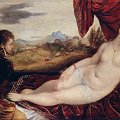 The "Venus and
Cupid with an Organist" and the "Venus and the Lute Player"
are variations on the theme of the earlier "Venus of Urbino".
Aside from the emphasis on the idealized beauty of the nude goddess,
it is generally believed that symbolism is involved in these pictures,
although the precise meanings have been variously interpreted. Beauty
of sound (music) and beauty of vision are common to both. In the first
example, a Renaissance garden with fountain and trees in perspective
completes the background, which is separated from the figures by a
dark red velvet curtain. More symbolism of an erotic nature is present
in the embracing couple, a stag, and the satyr on the fountain. In the
second picture, the background consists of a broad river valley and
the distant Alpine peaks so dear to Titian's heart. This late
landscape, painted in the artist's free illusionistic style, is
extraordinarily beautiful.
The "Venus and
Cupid with an Organist" and the "Venus and the Lute Player"
are variations on the theme of the earlier "Venus of Urbino".
Aside from the emphasis on the idealized beauty of the nude goddess,
it is generally believed that symbolism is involved in these pictures,
although the precise meanings have been variously interpreted. Beauty
of sound (music) and beauty of vision are common to both. In the first
example, a Renaissance garden with fountain and trees in perspective
completes the background, which is separated from the figures by a
dark red velvet curtain. More symbolism of an erotic nature is present
in the embracing couple, a stag, and the satyr on the fountain. In the
second picture, the background consists of a broad river valley and
the distant Alpine peaks so dear to Titian's heart. This late
landscape, painted in the artist's free illusionistic style, is
extraordinarily beautiful.
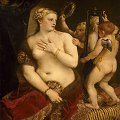 The "Venus with a
Mirror", the one original among several versions, is a natural theme
for the goddess of love and beauty. Yet Titian is the first artist to
show her with a mirror held by Cupid. Her form is somewhat more heroic
than hitherto, and her head to a limited degree is inspired by ancient
sculpture.The superb quality of the flesh tones is enhanced by the
cloak of dark red velvet, trimmed with fur.
The "Venus with a
Mirror", the one original among several versions, is a natural theme
for the goddess of love and beauty. Yet Titian is the first artist to
show her with a mirror held by Cupid. Her form is somewhat more heroic
than hitherto, and her head to a limited degree is inspired by ancient
sculpture.The superb quality of the flesh tones is enhanced by the
cloak of dark red velvet, trimmed with fur.
A group of several important pictures of mythological themes was created by the master in 1554-62 for Charles's successor, Philip II of Spain, who never bothered to remunerate Titian for any of them.
The "Perseus and Andromeda" was intended to be a companion to "Medea and Jason", according to Titian's letter, but for some reason the second picture was never carried out. Andromeda, bound to the rock at the left, awaits deliverance as Perseus descends from the sky to slay the monster. Her powerful physique reflects Titian's familiarity with the work of Michelangelo, yet Andromeda's body is more feminine and graceful than any of the Florentine's masculine-looking women. Titian's sensitivity to female beauty is unfailing.
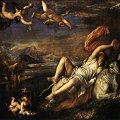 "The Rape of Europa" is surely one of the
gayest of Titian's "poesies", as he called them. Taken by surprise,
Europa is carried off, arms and legs flying, on the back of Jupiter in
the form of a garlanded white bull. A putto (chubby, naked little boy)
on the back of a dolphin appears to be mimicking her, and cupids in
the sky follow the merry scene. Titian's fondness for oblique
compositions is most successfully applied here, for it contributes to
the sense of movement, and it allows for the extensive seascape and
the mountainous shore. The sheer wizardry of Titian's technique is
nowhere more fully demonstrated than in the misty distances shot
through with blues and sunset rose and in the expanse of sea with its
iridescent lights. In "The Rape of Europa" Titian reached the
climax of his powers, and by good fortune the picture has survived in
almost perfect condition.
"The Rape of Europa" is surely one of the
gayest of Titian's "poesies", as he called them. Taken by surprise,
Europa is carried off, arms and legs flying, on the back of Jupiter in
the form of a garlanded white bull. A putto (chubby, naked little boy)
on the back of a dolphin appears to be mimicking her, and cupids in
the sky follow the merry scene. Titian's fondness for oblique
compositions is most successfully applied here, for it contributes to
the sense of movement, and it allows for the extensive seascape and
the mountainous shore. The sheer wizardry of Titian's technique is
nowhere more fully demonstrated than in the misty distances shot
through with blues and sunset rose and in the expanse of sea with its
iridescent lights. In "The Rape of Europa" Titian reached the
climax of his powers, and by good fortune the picture has survived in
almost perfect condition.
The great master died of old age in 1576, while a plague was raging in Venice. He was interred in the church of Sta. Maria dei Frari, where two of his most famous works may still be seen.
Through his long life Titian was highly successful in all branches of the painter's art. In his interpretation of Christianiconography he was infused in his youth with the poetic styles of the elderly Giovanni Bellini and his contemporary Giorgione. Titian created new compositions such as the "Assumption" and the "Pesaro Madonna" and later in his life the "Martyrdom of St. Lawrence", and he carried out a never-ending succession of new conceptions as his career matured. He gained international fame as a portraitist, beginning as a Giorgionesque painter and developing into a major creator of the state portrait for the glorification of rulers. The revival of the culture of the ancient world lies at the root of Renaissance culture in the arts and in literature; inspired by the ancient poets such as Ovid, Catullus, and Theocritus, Titian recreated pictorially the legends of Greece and Rome in a series of incomparable masterpieces.
Church of the Frari
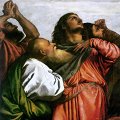 In the
great Gothic church of Santa Maria Gloriosa dei Frari in
Venice, Titian worked on two altarpieces that progressively
moved away from the rigid centralized schemes of the Early Renaissance
to form a new style. In the Assumption of the Virgin (1518),
the composition follows the dynamism of the action. To the excitement
of the apostles below, angels raise the Virgin towards the open arms
of the Lord. It is a picture of motion, light, and colour, in which
all the movement follows a circular rhythm, immersed in an atmosphere
of golden light, moving from the dark tones of the earth to the
brilliance of the heavens. In Madonna of the House of Pesaro,
commissioned in 1519 for a lateral altar in the Frari, Titian adopted
a strong diagonal composition in preference to the traditional
centralized scheme. He placed the Virgin Mary to one side, against one
of two vast columns that soar up and disappear out of sight. The
configuration of the saints and donors conforms to Titian's
diagonal-triangular principle; the primary point of the triangle being
the Virgins head, the other points formed by the heads of the two
kneeling chiefs of the Pesaro family.
In the
great Gothic church of Santa Maria Gloriosa dei Frari in
Venice, Titian worked on two altarpieces that progressively
moved away from the rigid centralized schemes of the Early Renaissance
to form a new style. In the Assumption of the Virgin (1518),
the composition follows the dynamism of the action. To the excitement
of the apostles below, angels raise the Virgin towards the open arms
of the Lord. It is a picture of motion, light, and colour, in which
all the movement follows a circular rhythm, immersed in an atmosphere
of golden light, moving from the dark tones of the earth to the
brilliance of the heavens. In Madonna of the House of Pesaro,
commissioned in 1519 for a lateral altar in the Frari, Titian adopted
a strong diagonal composition in preference to the traditional
centralized scheme. He placed the Virgin Mary to one side, against one
of two vast columns that soar up and disappear out of sight. The
configuration of the saints and donors conforms to Titian's
diagonal-triangular principle; the primary point of the triangle being
the Virgins head, the other points formed by the heads of the two
kneeling chiefs of the Pesaro family.
© H. W.
Titian Art

|
|
More
Articles
 Art Encyclopedia A world history of art in articles.
Art Encyclopedia A world history of art in articles.
Renaissance
Titian
Art and life.
Early art works by Titian.
Late art works by Titian.
Art
 Art Wallpapers Art image collections for your desktop.
Art Wallpapers Art image collections for your desktop.
Della Francesca Art, $19
(95 pictures)
Da Vinci Art, $25
(80 pictures)
Michelangelo Art, $29
(180 pictures)
Raphael Art, $25
(125 pictures)
Titian Art, $29
(175 pictures)
Durer Art, $25
(120 pictures)

